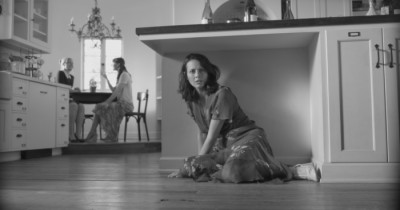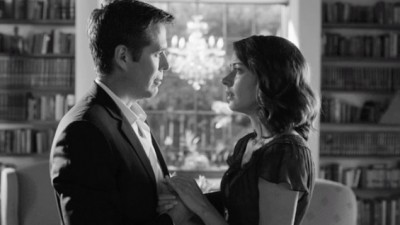
Shot in a whirlwind 12 days at his Santa Monica home, Joss Whedon’s take on Shakespeare’s Much Ado About Nothing reflects much of the off-the-cuff freshness and almost none of the inherent drawbacks of that pace. The film is mostly populated with names that mean a lot to fans of Whedon’s TV work, but not much to those of us who aren’t part of the so-called “Whedonverse.” (Not being a Whedonite, all I recognized were Clark Gregg and Nathan Fillion—from movies.) I actually think the lack of recognizable names works in the film’s favor by adding a sense of newness and spontaneity to the enterprise. It manages to feel like the logical outgrowth of Whedon’s house parties, in which he and his friends acted out Shakespeare. That’s exactly what the film is.

Now, I am not claiming that the movie is flawless. It takes awhile to hit its stride — only the leads, Amy Acker’s Beatrice and Alexis Denisof’s Benedick, seem fully at ease in the early scenes. And there are a few—very few—not-so-hot choices along the way. For example, Whedon chose to have Benedick “play” the scene in which he “overhears” a conversation staged for his benefit very broadly — and it comes across more embarassing than funny. And while I know I’m in the minority, I wasn’t entirely taken with Nathan Fillion’s Dogberry, though he has his moments. Overall, though, Whedon’s Shakespeare movie is something of a delight. Shot in digital black and white, the film has a terrific, sometimes shimmering look. One scene—a candlelit memorial procession—is in fact one of the most striking things I’ve seen this year.

Placing Shakespeare’s romantic comedy in modern dress works in unexpected ways, not the least of which is that the approach reveals the play to be the world’s first screwball comedy. It might, in fact, play even better in a 1930s milieu, but this will do. The whole business of Beatrice and Benedick as two strongheaded characters who appear to detest each other — even though everyone else knows otherwise — would be perfectly suited to Cary Grant and Irene Dunne in 1937. (The film’s black-and-white imagery underscores this.) True, the secondary romance and the plot of ruining the ingenue’s character through a slanderous lie plays less effectively these days, but its impact on Beatrice and Benedick effectively sets off what we now think of as the penultimate gloomy reel in a romantic comedy in which two lovers are separated by some misunderstanding.

The decision to shoot the film at Whedon’s house was obviously a budgetary one, but it works surprisingly well, as the house and grounds provide an apt setting. At one point, it even adds a visual gag by having Benedick make do with guest lodgings in a little girl’s bedroom. It’s just one more thing that went right for a film that seems to have had a kind of charmed life from the onset. Will it make a fortune? Probably not. Will its stars go on to full movie-star status? While Amy Acker probably ought to be a star, this too seems unlikely. Putting all that aside, this movie is a simple charmer and refreshing change of pace during blockbuster season. Don’t miss the break from all the bombast and noise. Rated PG-13 for some sexuality and brief drug use.
Playing at Carolina Cinemas and Fine Arts Theatre




I wasn’t altogether sure how this would work for me, but was massively charmed by this movie – particularly and predictably by the Beatrice and Benedick business. The screwball comedy element that you identified contributes a lot toward the fun I had with the film.
I’d agree that way Beatrice overhears of Benedick’s affections works better for the movie (and is somehow more visually interesting in its under the kitchen counter simplicity), but the corresponding Benedick scene still impressed me far more as being pleasantly goofy rather than “embarrassing”.
I really enjoyed the sly and confident imagination at work –even if it seems like a simple enough thing– regarding what I guess you might consider stage-blocking, and just giving characters things to do and ways of interacting with their surroundings (and non-verbally with each other) as they recite Shakespeare’s prose. A lot of the instances that impressed me or simply entertained me were scenes involving Dogwood and his dimwitted band of detectives. So nope, not ready to join you in the minority that wasn’t overly taken by Nathan Fillion’s portrayal. (Then again, had I seen Keaton’s turn in Branaugh’s version maybe I’d feel different?)
I wonder if Whedon won’t be hosting anymore 12-day Shakespeare parties in the future. Adding a Problem Play and a Tragedy might make for a neat trilogy.
(Then again, had I seen Keaton’s turn in Branaugh’s version maybe I’d feel different?)
If you like vintage Keaton (and I sure do), I think you would/will.
Haven’t seen it, so I can’t weigh in.
Now you both may:
http://www.youtube.com/watch?v=BmFu42uvomg
http://www.youtube.com/watch?v=82dYxF3sA8o
Yeah, I’d say Keaton wins.
That just backs up this report from a few years ago: http://www.theonion.com/articles/study-87-percent-of-movies-would-be-better-with-mi,19268/
Study: 87 Percent Of Movies Would Be Better With Michael Keaton In Them
LOS ANGELES
Explain White Noise.
It would’ve been 87% worse without Michael Keaton in it.
That would make it about negative four stars.
Well I’m not about to watch it.
I didn’t say you should.